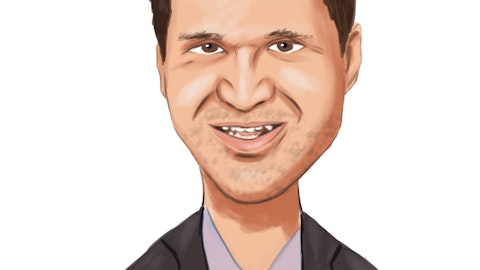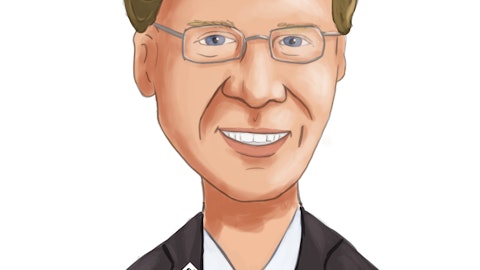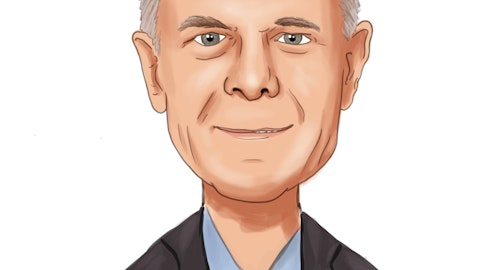And clearly, that doesn’t cost us anything. It’s just an effort of getting loan tapes to those places and making sure that they’re accepted. And so that was a little bit of work that we went through over the last month. We think that, that’s a prudent thing to do. We do not intend to use that capacity, but it’s there for us in a severe, adverse or an unexpected situation.Kevin Blair And Jamie, Chris, maybe I thought I heard you say the draw we took this quarter was done out of an abundance of caution, just to have extra liquidity in case we were to see some outflows, and we didn’t need extra collateral for that draw. We had capacity, what Jamie was talking about was the incremental capacity that we added during the quarter just to have additional contingent funding available if we needed it.Christopher Marinac No, that all makes sense.
And for whatever future episodes occur in the marketplace, you’re that much more prepared. So that makes a lot of sense. Thank you for all the information. It is very helpful.Kevin Blair Thanks Chris. Operator The next question comes from Samuel Varga from UBS. Samuel, your line is open. Please go ahead. Samuel Varga Good morning. Kevin Blair Good morning Sam.Samuel Varga I wanted to start just one more question on credit. With the shift of the part of the consumer book in the held for sale, I wanted to ask specifically just on kind of what the thought process was behind that? And then converse, I guess, are you seeing any sort of underlying trends that made you more cautious on that particular book that you moved?Robert Derrick Yes, I’ll start, and maybe Jamie can cover the held for sale.
Sam, this is Bob. But from a credit perspective, the move of — that was a third-party move and just simplistically stated, we built that third-party book during the excess liquidity period that we were in during the pandemic and when we were going the other direction with liquidity. So it was viewed as an investment alternative as a surrogate to the investment portfolio and a good yielding move for us on — without taking a whole lot of duration risk and some limited, what I would call limited credit risk. And now we’re just kind of exiting that position. And again, I think validating that there wasn’t a whole lot of credit risk there as we took a $6 million charge to make that transfer.But from the underlying consumer credit quality, and I would include small business loans in that category, Sam, since we do a lot of that through our retail network, we’ve seen moderate migration in credit metrics or moderate deterioration.
Most of our mortgage portfolio is private wealth in possession [ph]. So it’s holding up fairly well. We do have an affordable program that we’re actually very proud of that we use to support lower income in LMI districts. And we have seen some deterioration there. But again, we think we’re working with those borrowers have great programs and assistance programs that we provide and proud to do that in our markets actually. So overall credit in the consumer book is kind of stable with some slight deterioration in small business. And Jamie, on the accounting side?Jamie Gregory Yes. As we think about that portfolio, the auto portfolio we moved to held for sale, that’s something we began talking about in, I believe, in October after third quarter earnings and a process that we’ve been proceeding down.
And we moved into held for sale, and then the month of March happened and there’s just more uncertainty out there. And so it’s our intent to sell that portfolio. As Bob mentioned, the credit is performing very well. They are also shorter duration assets and so there are assets that we like. We think that there’s a good profile, good risk-adjusted return. But given the last month, I would say that it’s a little more uncertain out there, the environment to sell loans like this. But what we would continue to intend to sell it, and we’ll continually reassess as we see where the market is on that.Samuel Varga Got it. I appreciate the color. And then if I could just have one more in there. Jamie, I appreciate the color you gave on the deposit beta assumptions and how those are moving around and I guess, what the mix impact on that.
Would you be able to give some specific color on the interest-bearing deposit beta?Jamie Gregory As you think about interest-bearing deposit beta, we were at 43 in the first quarter. And as I mentioned, in the month of March, a little bit higher in interest-bearing deposit costs. That gets you to the cycle interest-bearing deposit costs of 47. It’s — the mix is really important when you think about what happens from here as we get later in the cycle. But we could see that approach 60% as you get out into the third quarter.Samuel Varga Got it, it’s very helpful. Thanks for taking my questions. Operator This concludes our question-and-answer session. I would like to turn the conference back over to Mr. Kevin Blair for any closing remarks. Thank you.Kevin Blair Thank you, Adam.





